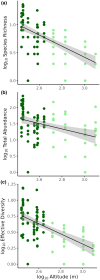Fish diversity of Colombian Andes-Amazon streams at the end of conflict is a reference for conservation before increased land use
- PMID: 38487746
- PMCID: PMC10937820
- DOI: 10.1002/ece3.11046
Fish diversity of Colombian Andes-Amazon streams at the end of conflict is a reference for conservation before increased land use
Abstract
Reference conditions are difficult to find in the Anthropocene but essential for effective biodiversity conservation. Aquatic ecosystems in the Andes-Amazon transition zone of Colombia are now at high risk due to expanded human activities after peace agreements in 2016 ended armed conflict because lands formerly controlled by FARC and other armed groups are now prone to agricultural and urban expansion. Particularly, expanding human land use may reduce fish diversity across the altitudinal gradient, especially in the premontane streams (i.e., <500 m a.s.l.) because lands are more amenable to human use than at greater altitudes. We evaluated fish α-diversity (measured as species richness, total abundance, and effective species number) and β-diversity (spatial and temporal) in 12 sites over 8 years bracketing the end of armed conflict. All α-diversity and β-diversity analyses were evaluated relative to categorical altitude (< or >500 m) and continuous altitude. Strong differences in fish community structure among sites occurred as a function of altitude. Fish communities exhibit altitudinal biodiversity gradients that are consistent in space and time, and that need to be accounted for conservation and management considerations. Our results provide a reference to identify short- and long-term changes due to impending human land use at a critical moment for the conservation of tropical fish diversity. Similar studies in other areas of the upper Amazon Basin are needed to evaluate effects of subsequent human activities on diversity patterns and our study area to compare to reference conditions reported here.
Keywords: Amazon piedmont; abundance; altitudinal gradient; beta diversity; effective diversity; land use; multivariate analysis; species richness.
© 2024 The Authors. Ecology and Evolution published by John Wiley & Sons Ltd.
Conflict of interest statement
All authors declare that there are no competing interests.
Figures





Similar articles
-
Altitudinal variation in fish assemblage diversity in streams of the central Andes of Colombia.J Fish Biol. 2010 Jun;76(10):2401-17. doi: 10.1111/j.1095-8649.2010.02629.x. J Fish Biol. 2010. PMID: 20557599
-
Fish biodiversity and assemblages along the altitudinal gradients of tropical mountainous forest streams.Sci Rep. 2021 Aug 19;11(1):16922. doi: 10.1038/s41598-021-96253-3. Sci Rep. 2021. PMID: 34413385 Free PMC article.
-
[[Which factors determine the altitudinal distribution of tropical Andean riverine fishes]?].Rev Biol Trop. 2016 Mar;64(1):157-76. Rev Biol Trop. 2016. PMID: 28862413 Spanish.
-
Elevational biodiversity gradients in the Neotropics: Perspectives from freshwater caddisflies (Insecta: Trichoptera).PLoS One. 2022 Aug 5;17(8):e0272229. doi: 10.1371/journal.pone.0272229. eCollection 2022. PLoS One. 2022. PMID: 35930543 Free PMC article.
-
Spatial diversity patterns of Pristimantis frogs in the Tropical Andes.Ecol Evol. 2016 Feb 19;6(7):1901-13. doi: 10.1002/ece3.1968. eCollection 2016 Apr. Ecol Evol. 2016. PMID: 26929819 Free PMC article.
References
-
- Achiso, Z. (2020). Biodiversity and human livelihoods in protected areas: World‐ wide perspective—A review. SSR Institute of International Journal of Life Sciences, 6(3), 2565–2578.
-
- Adhikari, A. , & Hansen, A. J. (2018). Landscape and urban planning land use change and habitat fragmentation of wildland ecosystems of the North Central United States. Landscape and Urban Planning, 177, 196–216. 10.1016/j.landurbplan.2018.04.014 - DOI
-
- Agudelo Córdoba, E. , Sánchez, C. , Rodríguez, C. , Bonilla‐Castillo, C. , & Gómez, G. (2011). Diagnóstico de la pesquería en la cuenca Amazonas. In Lasso C. A., Morales‐Betancourt M. A., González‐Cañón G., Ajiaco‐Martínez R. E., Valderrama Barco M., Hernández Barrero S., Ortega Lara A., Rodríguez Fernández C. A., Álvarez León R., Agudelo Córdoba E., Bonilla Castillo C. A., Gómez Hurtado G. A., Barreto‐Reyes C., & Sánchez Páez C. L. (Eds.), II. Pesquerías continentales de Colombia: cuencas del Magda‐ lena‐Cauca, Sinú, Canalete, Atrato, Orinoco, Amazonas y vertiente del Pacífico. Serie Editorial Recursos Hidrobiológicos y Pesqueros Continentales de Colombia, 13(2152), 1–14. (pp. 143–166). Instituto de Investigación de los Recursos Biológicos Alexander von Humboldt.
-
- Agudelo, E. , Alonso, J. C. , & Moya, L. (2006). Perspectivas para el ordenamiento de la pesca y la acuicultura en el área de integración fronteriza Colombo‐Peruana del río Putumayo .
LinkOut - more resources
Full Text Sources

